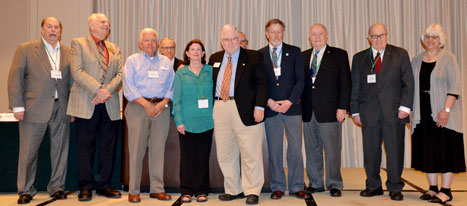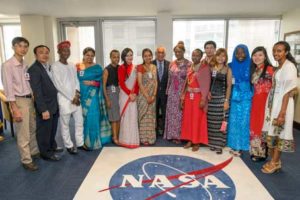 While I appreciate, and have even contributed to, the extensive literature on the underrepresentation of women in the professoriate and the challenges for their recruitment and retention, I am struck by the more limited literature on the well-being of women in departments that have, or are approaching, numbers of female faculty that are reflective of the percentage of women earning PhDs in a discipline or even the percentage of women in the general population. As the number of women on geography faculties continues to grow, the latter becomes an increasingly important consideration. To help explore this issue, I first present two scenarios of large PhD-granting departments located within research-intensive universities.
While I appreciate, and have even contributed to, the extensive literature on the underrepresentation of women in the professoriate and the challenges for their recruitment and retention, I am struck by the more limited literature on the well-being of women in departments that have, or are approaching, numbers of female faculty that are reflective of the percentage of women earning PhDs in a discipline or even the percentage of women in the general population. As the number of women on geography faculties continues to grow, the latter becomes an increasingly important consideration. To help explore this issue, I first present two scenarios of large PhD-granting departments located within research-intensive universities.
In Department #1, 20 percent of the tenure-track faculty are women, a proportion that is substantially below the percentage of women earning PhDs in this discipline over the past several decades. Recent hires at all levels (assistant, associate and full professor) have been disproportionately men, although a senior woman was hired to lead a research institute affiliated with the department, and another woman was hired as an endowed chair. Approximately half of the female faculty hold the rank of full professor, and the current associate chair of the department is a woman. The salaries of the female faculty fall near the median value of the salaries earned by male colleagues at a similar rank. Women collaborate with colleagues within the department at approximately the same rate as the male faculty, and they are equally likely to collaborate with men as with women. In terms of social interaction, most faculty, including the department chair, share their lunch times in the departmental conference room, where they informally discuss their current research, upcoming conferences, publication and grant opportunities and practices, and other professional topics.
In Department #2, the representation of female faculty is much higher. Here women compose 40 percent of the tenure-track faculty, which compares favorably with the proportion of women earning PhDs in this discipline over the past ten years. The current hiring rate of women exceeds that of men at the assistant professor level; however, none of the recent senior hires have been women. Proportionally, representation of women is much less at the full professor level compared to the assistant and associate ranks. Positions of prestige and/or leadership (e.g., endowed chair, distinguished professor, chair, associate chair, directors of research institutes) are all held by men. The salaries of the female faculty fall near or at the bottom of the scale for their respective ranks, even after adjusting for time in rank. The female faculty have fewer collaborators compared to the male faculty, and are more likely to collaborate with other women. Department social interactions, whether group lunches, coffee breaks, or light conversation, are gender-segregated. This extends to the chair’s social interactions with faculty.
Based on numbers alone, Department #1 might appear to someone in higher administration to have a “chillier climate” for women. Certainly, departments where the number of female faculty is considerably below disciplinary proportions need to be carefully scrutinized, and improved recruitment and retention of women must be a priority and an expectation. But administrators also need to closely monitor the developments exemplified in Department #2. The second scenario was developed to highlight the impact of what Liisa Husu at Örebro University refers to as “non-events.” In a recent interview published in Nature, Professor Husu commented that “I have found that it is not only the things that happen to women … that affect them in pursuing a career in science or that slow their career development. It is also the things that do not happen: what I call ‘non-events.’ Non-events are about not being seen, heard, supported, encouraged, taken into account, validated, invited, included, welcomed, greeted, or simply asked along … A single non-event — for example, failing to cite a relevant report from a female colleague — might seem almost harmless but the accumulation of such slights over time can have a deep impact.” Husu points out that “non-events” can be difficult to address, or in her words, “Nothing happened so why the fuss?”
Husu’s remarks resonated strongly with me, and I used her concept of “non-events” to develop a short checklist for evaluating the well-being of faculty that I presented at the 2013 AAG Chair’s Symposium on Promoting Diversity. I repeat three of these indicators here, ones that I personally have found to be particularly reflective of faculty well-being, and use the two scenarios above to illustrate.
Do all faculty have access to the primary social activities and the accompanying informal information exchange within the department? Hypothetical Department #1 has the edge here, as the major departmental social activity focuses explicitly on the sharing of professional experiences and is open to all faculty interested in participating. Furthermore, the daily availability of social discussions allows faculty within this department to participate frequently, yet still accommodate other responsibilities. On the other hand, female faculty in Department #2 are left out of the department’s major avenues for informal information exchange, with potential implications including a lack of informal mentoring, less opportunity to develop collaborations with departmental colleagues, less awareness by male faculty of the activities and accomplishments of their female colleagues, and, for the scenario presented here, less access to the department chair.
Are women hired for faculty positions at all ranks? Improvements in hiring practices are needed for both hypothetical departments. The few recent hires of women by Department #1 suggest that recruitment is an issue and that search committees are not aggressively identifying potential female candidates. As Mary Ann Holmes and her colleagues recently wrote in Nature Geoscience, faculty search committees too often forget that “search” is an active verb. For Department #2, the concern is that only men have been hired into senior positions. This can disrupt the gender balance at the senior ranks, even if men and women who enter the department as assistant professors are tenured and promoted at the same rate. Also, as senior positions usually come with greater research and/or administrative expectations, the faculty hired in these positions typically receive teaching reductions and substantial start-up funding which can lead to greater research success and on-campus profiles, compared to senior women who are likely balancing more traditional research and teaching expectations. Hypothetical Department #1 successfully hired two senior female faculty, but for many departments this can be difficult, as often initiatives to improve representation primarily come from the underrepresented faculty themselves. Female faculty, especially if they are not administrators, may not have the savvy to initiate a senior hire, especially one outside of normal search procedures, or the clout to make it happen.
Are male and female faculty earning comparable salaries? Many authors, including myself, have investigated the differences in faculty salary by gender, although the findings are sometimes conflicting, partly a small numbers problem. But as the number of female faculty increases, salary become more of a litmus test of well-being among female faculty. In Department #1, the small number of women makes it difficult to identify the existence (or lack) of gender differences in salary, but for Department #2, where the representation by women is greater, their lower salaries are potentially indicative of constraints that are influencing the relative productivity and success of female faculty.
Obviously, the two scenarios presented above are dramatized, and most departments actually share some characteristics with both the hypothetical departments. Also, some readers may argue for different or additional indicators of faculty well-being. My point, though, is that as the number of female faculty in geography increases, we need to closely gauge, and rectify, the influence of non-events and subtle biases on women’s success and satisfaction with their positions. After all, the strongest and most creative geography departments are those where all faculty are successful and respected.
I look forward to your comments.
Julie Winkler
DOI: 10.14433/2014.0008
[For more information on the articles referred to above see “Scientists of the world speak up for equity”, Nature, 2013, Vol. 495, p. 35-38. DOI:10.1038/495035a, and “Gender parity in the geosciences: data and geoscientists’ perceptions”, Nature Geoscience, 2008, Vol. 1, p. 79-82. DOI:10.1038/ngeo113.]


